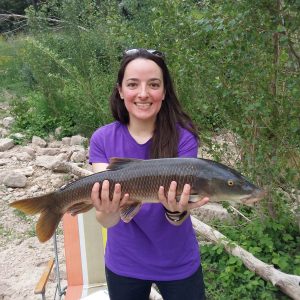Ecohydraulic study of Iberian fish migration
| PhD in Conservation and Sustainable Use of Forest Systems |
| Doctor: Ana García Vega |
| Date of reading: 20/05/2021 |
| Directors: Dr. Francisco Javier Sanz Ronda (ETSIIAA, Universidad de Vallladolid) |
| Court: Dr. José Barquín Ortiz (IHA, Universidad de Cantabria), Dr. Andrés Martínez de Azagra Paredes (ETSIIAA, Universidad de Valladolid), Dr. Theodore Castros-Santos (S.O. Conte Anadromous Fish Research Center, USGS / University of Massachussets) |
Introduction
 Many fish species need to move between different habitats in order to complete their life cycles. As a result, migration responds to internal and external factors, with environmental variables, such as river flow and thermal regimes, acting as the main stimuli for the onset and maintenance of migratory behavior in freshwater fish. Moreover, river fragmentation and anthropogenic alterations on these variables (e.g. river regulation) may have strong impacts on fish populations, which could be aggravated by future projections of climate change and increasing water demand. Thus, to assess these impacts and define mitigation measures, it is vital to understand fish movement patterns and the environmental variables affecting them.
Many fish species need to move between different habitats in order to complete their life cycles. As a result, migration responds to internal and external factors, with environmental variables, such as river flow and thermal regimes, acting as the main stimuli for the onset and maintenance of migratory behavior in freshwater fish. Moreover, river fragmentation and anthropogenic alterations on these variables (e.g. river regulation) may have strong impacts on fish populations, which could be aggravated by future projections of climate change and increasing water demand. Thus, to assess these impacts and define mitigation measures, it is vital to understand fish movement patterns and the environmental variables affecting them.
Native Iberian fish fauna presents the greatest European percentage of endemism, characterized by a low number of families, with most species belonging to the Cyprinidae family. The most representative species from this family are barbels and nases, for example, the Iberian barbel and the Northern straight-mouth nase. However, scarce information exists regarding the ecological requirements of these endemic species during their upstream migration. Another important family in the Iberian Peninsula, in terms of recreational fishing and ecological traits, is the Salmonidae, the brown trout being one of the most representative salmonids worldwide. Although this species has been deeply studied, most available research has been focused on anadromous populations, and studies in the south of its natural distribution are still scarce.
Objectives
The present thesis aims to cover some of these research gaps regarding upstream migration patterns of Iberian barbel, Northern straight-mouth nase and brown trout (both potamodromous and anadromous ecotypes), as well as to determine the environmental conditions which trigger these movements. In addition, this information is used to evaluate the effect of human impacts and assess the effect of mitigation measures on these species.
Development
In order to achieve this, the long-term movement data of these three species in four different locations of the Iberian Peninsula (Porma River (León), Tormes River (Salamanca), Marín River (Navarra) and Bidasoa River (Navarra)) were gathered, analyzed and discussed. In all the studied cases, data were collected in fishways, since they are mandatory points of passage during upstream migration. Survival analysis techniques were used to study median migration dates and patterns. Subsequently, random forest regression was used to evaluate the influence of environmental variables on the number of captures, develop models that can predict when upstream movements were more likely to occur, evaluate different scenarios of river discharge and water temperature and assess the possible effects of management and restoration actions.
Conclusions
The long-term monitoring is an essential tool, not only for identify population changes, migration patterns and cues, but also for the evaluation of the overall effect of changes in the parameters involved in the migration and assessing the effects of mitigation measures. Therefore, continuous monitoring studies are necessary to define adaptive strategies and reliable management plans to ensure the conservation of Iberian freshwater fish.
